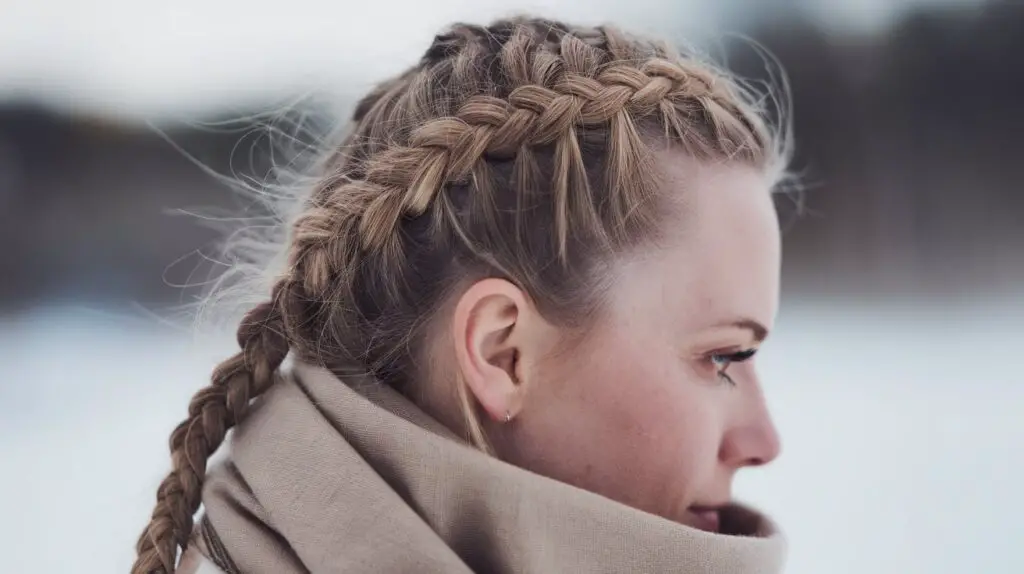Dutch braids are a stylish and practical hairstyle that’s perfect for cold weather. These braids start at the crown of the head and work downward, incorporating hair from the sides as you go. The result is a snug, close-to-the-scalp braid that looks beautiful and keeps hair neatly tucked away.
Cold weather can be tough on hair, causing dryness, static, and frizz. Dutch braids offer a solution to these winter hair woes. By keeping hair contained and protected, they minimize exposure to harsh elements like wind, snow, and cold air. This protective style also helps retain moisture, preventing the dreaded winter hair breakage.
In the following sections, we’ll share tips on creating long-lasting Dutch braids that can withstand winter conditions. We’ll cover techniques for making your braids durable, discuss which hair types work best with this style, and explore ways to protect your braids from harsh weather. Plus, we’ll look at some stylish variations to keep your winter look fresh and fun. Keep reading to master the art of Dutch braids for cold weather.
- What makes Dutch braids long-lasting?
- How to create durable Dutch braids for winter
- Which hair types work best for long-lasting Dutch braids?
- How to protect Dutch braids in harsh winter conditions
- What are the best styling variations for winter Dutch braids?
- Mastering Dutch Braids: Your Winter Hair Solution
- Frequently Asked Questions
What makes Dutch braids long-lasting?

Dutch braids are known for their durability, making them an excellent choice for cold weather. But what exactly makes these braids stand the test of time? Let’s explore the key factors that contribute to their longevity.
Tight weaving technique
The foundation of a long-lasting Dutch braid lies in the weaving technique. Unlike regular braids, Dutch braids are created by crossing the hair under rather than over. This method results in a tighter, more secure braid that hugs the scalp. To achieve this, start with small sections of hair and maintain consistent tension as you braid. Remember, the tighter the weave, the longer your braid will last.
Use of hair products
Hair products play a crucial role in extending the life of your Dutch braids. Before braiding, apply a lightweight styling cream or mousse to damp hair. This helps to:
- Control frizz and flyaways
- Add grip to slippery strands
- Provide hold without stiffness
- Nourish and protect hair from cold weather damage
After braiding, a light mist of hairspray can help set the style and keep stray hairs in place.
Proper sectioning
Accurate sectioning is often overlooked but is vital for creating long-lasting Dutch braids. Start by parting your hair down the middle, from forehead to nape. Then, divide each side into three equal sections. This precise division ensures that your braids will be symmetrical and balanced, reducing the likelihood of loose strands escaping over time.
How do you maintain clean sections while braiding? Use hair clips to keep unbraided sections out of the way. This simple trick prevents tangling and helps you focus on one section at a time, resulting in neater, more durable braids.
Secure fastening
The way you secure your Dutch braids can make or break their longevity. Avoid using regular elastic bands, as they can slip and cause the braid to unravel. Instead, opt for small, clear elastic bands or fabric-covered hair ties. These provide a stronger hold without damaging your hair.
For extra security, try this pro tip: after securing the end of your braid with an elastic, wrap a small section of hair around the elastic and pin it in place with a bobby pin. This not only hides the elastic but also adds an extra layer of hold.
Regular maintenance
Even the most well-crafted Dutch braids require some upkeep to stay fresh and intact. Gently smooth down any flyaways with a soft-bristled brush or your fingers, applying a small amount of hair oil or styling cream as needed. At night, protect your braids by sleeping on a silk or satin pillowcase, which reduces friction and helps prevent frizz.
How often should you redo your Dutch braids? While they can last up to a week, it’s best to refresh them every 3-4 days. This allows you to detangle your hair, give your scalp a break, and start anew with clean, well-moisturized strands.
By focusing on these key aspects – tight weaving, strategic product use, proper sectioning, secure fastening, and regular maintenance – you can create Dutch braids that withstand winter weather and keep your hair protected and stylish for days on end. With practice, you’ll find the perfect balance of technique and care that works for your hair type and lifestyle.
How to create durable Dutch braids for winter

Creating durable Dutch braids for winter requires attention to detail and the right techniques. Let’s explore how you can craft these stylish and long-lasting braids to keep your hair protected during the cold months.
Preparing your hair
Start with clean, slightly damp hair. Wash and condition your locks, then gently towel-dry. Apply a leave-in conditioner to add moisture and protect your hair from the harsh winter elements. For extra hold, work a small amount of mousse or styling cream through your strands.
Why is damp hair better for braiding? It’s more pliable and easier to manage, resulting in neater braids that stay put longer. However, avoid braiding soaking wet hair as it can lead to scalp irritation and may not dry properly.
Sectioning techniques
Proper sectioning is crucial for creating symmetrical, long-lasting Dutch braids. Begin by parting your hair down the middle, from your forehead to the nape of your neck. Use a fine-toothed comb for precision. Next, divide each side into three equal sections.
To keep unbraided sections out of the way, try this trick: twist each section and secure it with a small clip. This prevents tangling and makes the braiding process smoother.
Braiding method
Now for the main event – braiding. Start at the crown of your head with a small section of hair. Divide this into three strands. Unlike traditional braids, Dutch braids require you to cross the outer strands under the middle strand, not over.
As you braid, incorporate additional hair from the sides into each outer strand before crossing it under. Keep your movements consistent and maintain even tension throughout. This technique creates the characteristic raised braid effect.
A common question is: How tight should the braid be? Aim for snug but comfortable. Too loose, and your braid won’t last; too tight, and you risk headaches or hair breakage.
Securing the ends
Properly securing the ends of your Dutch braids is essential for longevity. When you reach the nape of your neck and have incorporated all your hair, continue braiding normally to the ends. Here are some tips for securing your braids:
- Use small, clear elastic bands for a neat finish
- Avoid rubber bands, which can cause breakage
- Consider using hair-colored elastics for a seamless look
- For extra security, tie a small ribbon around the elastic
Applying finishing products
The final step in creating durable Dutch braids involves applying the right finishing products. A light mist of flexible-hold hairspray helps tame flyaways and sets your style. For added shine and protection against winter dryness, warm a few drops of hair oil between your palms and gently smooth it over your braids.
How often should you reapply products? Touch up your braids with a small amount of styling cream or oil every other day to keep them looking fresh and prevent frizz.
By following these steps, you can create Dutch braids that withstand winter weather while keeping your hair protected and stylish. The key is to take your time, maintain consistent tension, and use products that suit your hair type. With practice, you’ll perfect your technique and enjoy beautiful, long-lasting braids throughout the cold season.
Remember, everyone’s hair is different. Don’t be discouraged if your first attempts aren’t perfect. Keep practicing, and soon you’ll be braiding like a pro, ready to face the winter with confidence and style.
Which hair types work best for long-lasting Dutch braids?

Dutch braids can be a fantastic winter hairstyle for various hair types, but some textures may require specific techniques to achieve long-lasting results. Let’s explore how different hair types can work with this versatile style.
Thick hair advantages
Women with thick hair often find that Dutch braids hold exceptionally well. The abundance of strands provides natural grip and volume, making it easier to create tight, secure braids. If you have thick hair, you’re in luck! Your braids are likely to stay put for days with minimal touch-ups.
However, thick hair can be heavy. To prevent your scalp from feeling strained, try dividing your hair into smaller sections when braiding. This distributes the weight more evenly and can make your style more comfortable for extended wear.
Fine hair considerations
Fine hair can be tricky when it comes to Dutch braids, as it tends to slip and loosen more easily. But don’t worry – there are ways to make this style work for you. The key is to add texture and grip to your hair before braiding.
Try these tips to help your fine hair hold Dutch braids longer:
- Use a texturizing spray before braiding
- Apply a small amount of dry shampoo for extra grip
- Slightly tease the roots for added volume
- Opt for smaller, tighter braids rather than large ones
Curly hair tips
Curly hair can create stunning Dutch braids with lots of texture and dimension. The natural coils provide excellent grip, helping the style stay intact. However, curly hair can also be prone to frizz, especially in winter weather.
To keep your curly Dutch braids looking sleek, start by applying a leave-in conditioner to damp hair. This helps smooth the cuticle and reduce frizz. When braiding, use a bit more tension than you would with straight hair to keep the curls contained. Finish with a light mist of anti-humidity spray to lock in your style.
Straight hair techniques
Straight hair can sometimes be challenging for Dutch braids, as it may lack the natural texture that helps braids stay put. But with the right approach, you can create beautiful, long-lasting braids.
Begin by adding some wave or texture to your hair. You can do this by braiding damp hair into several loose braids and sleeping on them overnight. In the morning, undo these braids and you’ll have subtle waves that provide more grip for your Dutch braids.
Another trick is to use a lightweight mousse before braiding. This adds just enough texture without weighing down your hair or making it feel sticky.
Mixed texture strategies
Many women have hair with mixed textures – perhaps wavy at the roots and straighter at the ends, or a combination of fine and thick strands. For mixed textures, the key is to customize your approach based on the different areas of your hair.
Start by identifying the various textures in your hair. You might need to use different products or techniques for each section. For example, you could apply a texturizing spray to smoother areas while using a leave-in conditioner on drier or frizzier sections.
When braiding, adjust your tension as needed. Pull tighter on slippery sections and looser on areas that have more natural grip. This balanced approach will help your Dutch braids look uniform and last longer.
Remember, practice makes perfect. Don’t be discouraged if your first attempts at Dutch braids don’t turn out exactly as you hoped. With time and experimentation, you’ll discover the best techniques for your unique hair type.
Regardless of your hair texture, proper care is essential for maintaining healthy hair and long-lasting braids. Regular deep conditioning treatments can help keep your hair moisturized and strong, especially during harsh winter months. This extra care will not only improve the longevity of your Dutch braids but also keep your hair looking its best when you choose to wear it down.
How to protect Dutch braids in harsh winter conditions
Winter weather can be tough on your hair, especially when you’re sporting Dutch braids. Cold temperatures, dry air, and harsh winds can wreak havoc on your carefully crafted style. Let’s explore some effective ways to shield your braids from the elements and keep them looking fresh throughout the chilly season.
Nighttime care routines
Your nighttime routine plays a crucial role in maintaining the integrity of your Dutch braids. Before bed, gently pat a small amount of lightweight hair oil along the length of your braids. This helps seal in moisture and prevent breakage.
But what about protecting your style while you sleep? Try wrapping your head in a silk or satin scarf. These smooth fabrics reduce friction, minimizing frizz and keeping your braids neat. If you find scarves uncomfortable, a silk or satin pillowcase can offer similar benefits.
Protective headwear options
Choosing the right headwear is essential for safeguarding your Dutch braids during winter outings. Opt for hats or beanies lined with silk or satin to prevent friction and static. Look for options with a loose fit to avoid crushing your braids.
Here are some headwear ideas that work well with Dutch braids:
- Wide-brimmed felt hats
- Slouchy beanies
- Earmuffs paired with a silk scarf
- Hooded jackets with soft linings
Remember to remove your hat carefully to avoid disturbing your braids.
Moisture-retention techniques
Winter air can quickly zap moisture from your hair, leaving your Dutch braids dry and prone to breakage. To combat this, incorporate regular deep conditioning treatments into your hair care routine. Apply a leave-in conditioner before braiding to provide long-lasting hydration.
Another effective technique is to use a humidifier in your home or office. This adds moisture to the air, helping your hair retain its natural oils. You might be surprised at how much difference this simple step can make in maintaining healthy, hydrated braids.
Frizz-fighting strategies
Frizz is often the nemesis of well-groomed Dutch braids, especially in winter. To keep flyaways at bay, try using an anti-frizz serum or hair oil. Apply it sparingly to the surface of your braids, focusing on areas prone to frizz.
Static electricity can also cause frizz in dry winter conditions. A quick fix is to run a dryer sheet lightly over your braids. This helps neutralize static and smooth down unruly strands. For a more natural option, you can use a small amount of coconut oil on your hands before smoothing your braids.
Touch-up methods
Even with the best care, your Dutch braids may need some touch-ups to stay looking fresh. Keep a small brush and some bobby pins in your bag for quick fixes on the go. If you notice loose strands, gently tuck them back into the braid and secure with a pin.
For a more thorough refresh, you can partially undo the bottom portion of your braids and re-braid them. This helps tighten up any sections that may have loosened over time. Apply a small amount of styling cream or gel to smooth down any frizz as you re-braid.
How often should you completely redo your Dutch braids? While they can last up to a week, it’s best to take them out and start fresh every 5-7 days. This allows you to thoroughly cleanse your scalp and give your hair a break.
By implementing these protective measures, you can enjoy beautiful, long-lasting Dutch braids throughout the winter months. The key is to be proactive in your care routine and attentive to your hair’s needs. With a little extra effort, your braids can withstand even the harshest winter conditions, keeping you stylish and your hair healthy all season long.
What are the best styling variations for winter Dutch braids?
Dutch braids offer a versatile foundation for numerous winter hairstyles. These practical and stylish plaits can be adapted to suit various occasions, from casual outings to formal events. Let’s explore some creative variations that will keep you looking chic throughout the cold season.
Double Dutch braid styles
The classic double Dutch braid style is a go-to for many women during winter. This look involves creating two parallel braids that run from your forehead to the nape of your neck. But why stop there? You can add a twist to this timeless style by varying the braid size or incorporating different textures.
For a more relaxed look, try loosening the braids slightly after you’ve finished plaiting. This creates a softer, more casual appearance that’s perfect for weekend brunches or shopping trips. Alternatively, for a sleeker style suitable for the office, keep the braids tight and use a small amount of gel to tame any flyaways.
Crown braid adaptations
Crown braids offer a regal look that’s both elegant and practical for winter weather. To create this style, start a Dutch braid at one temple and continue it around your head, following your hairline. When you reach the starting point, tuck the end of the braid underneath and secure it with bobby pins.
How can you make your crown braid stand out? Consider these ideas:
- Incorporate small flowers or berries for a winter wonderland vibe
- Weave a thin ribbon through the braid for a festive touch
- Add some volume to the top of your head for a more dramatic look
Braided bun variations
Combining Dutch braids with a bun creates a sophisticated style that’s perfect for holiday parties or formal winter events. Start by creating two Dutch braids, one on each side of your head. Instead of braiding all the way down, stop at the nape of your neck and secure the braids with elastic bands.
Now, here’s where you can get creative. Twist the loose ends of your hair into a bun, or create a more intricate design by wrapping the braids around each other to form a rose-like shape. Secure your chosen bun style with bobby pins and a light mist of hairspray.
Side-swept Dutch braid looks
Side-swept styles offer a romantic, slightly asymmetrical look that’s ideal for date nights or evening events. Begin your Dutch braid at one temple and continue diagonally across the back of your head, ending at the opposite shoulder. Leave some face-framing strands loose for a soft, feminine touch.
To elevate this style, try incorporating a fishtail braid technique into the last few inches of your plait. This adds an interesting textural element and showcases your braiding skills. Finish the look with a small hair accessory placed where the braid begins for an extra touch of glamour.
Accessorizing for cold weather
Winter provides ample opportunity to accessorize your Dutch braids. From cozy hats to glittering hair clips, the right accessories can transform your braided style and provide additional protection against the cold.
When choosing accessories for your winter Dutch braids, consider both style and function. A soft, knit headband can add warmth while showcasing your braids. Alternatively, decorative bobby pins or small hair combs can add sparkle to your style without interfering with hats or scarves.
For those extra chilly days, try this trick: wrap a colorful scarf around your head, leaving your braids visible. This not only keeps you warm but also adds a pop of color to your winter outfit.
Remember, the key to successful winter Dutch braid styles is balancing practicality with aesthetics. These variations allow you to protect your hair from harsh weather while still expressing your personal style. Experiment with different combinations of braiding techniques, accessories, and styling products to find the looks that work best for you.
As you try out these different styles, pay attention to how they interact with your winter wardrobe. A braided style that looks great with your favorite sweater might not work as well with a high-collared coat. By considering your entire look, you can create cohesive, stylish outfits that showcase your beautiful Dutch braids all winter long.
Mastering Dutch Braids: Your Winter Hair Solution
Dutch braids offer a perfect blend of style and practicality for the winter season. From classic double braids to elegant crown adaptations, these versatile plaits can be customized to suit any occasion. By incorporating various techniques and accessories, you can create looks that are both fashionable and functional, protecting your hair from harsh winter elements while expressing your personal style.
As you experiment with different Dutch braid variations, remember that practice makes perfect. Don’t be discouraged if your first attempts aren’t flawless – with time and patience, you’ll develop the skills to create stunning braided styles. Whether you’re heading to the office, attending a holiday party, or simply enjoying a cozy day at home, there’s a Dutch braid style that’s perfect for you. So embrace the winter season with confidence, knowing that your hair looks great and is well-protected from the cold.
Frequently Asked Questions
Q: What makes Dutch braids ideal for winter?
A: Dutch braids keep hair contained and protected from harsh winter elements like wind and cold air, helping to prevent dryness and breakage.
Q: How long can Dutch braids typically last?
A: With proper care, Dutch braids can last up to a week, but it’s best to refresh them every 3-4 days for optimal appearance and scalp health.
Q: What’s the best way to prepare hair for Dutch braiding?
A: Start with clean, slightly damp hair and apply a leave-in conditioner or styling cream for added grip and moisture protection.
Q: How can I make my Dutch braids last longer in winter?
A: Use a silk or satin pillowcase, apply a light hair oil before bed, and protect your braids with appropriate winter headwear.
Q: Are Dutch braids suitable for all hair types?
A: Yes, Dutch braids can work for various hair types, but different textures may require specific techniques or products for best results.
Q: What’s a simple way to dress up Dutch braids for a formal winter event?
A: Try a braided bun variation by creating two Dutch braids and twisting the ends into an elegant bun at the nape of your neck.
Q: How can I prevent frizz in my Dutch braids during winter?
A: Apply an anti-frizz serum or hair oil lightly over your braids, and use a humidifier at home to add moisture to the air.
Q: What are some winter-friendly accessories for Dutch braids?
A: Soft knit headbands, decorative bobby pins, and colorful scarves can add style to your Dutch braids while providing extra warmth.

